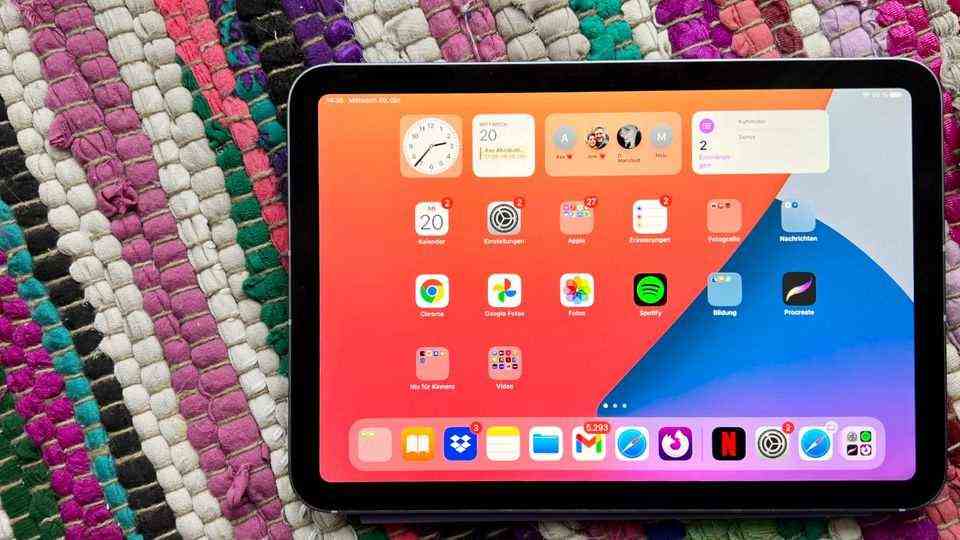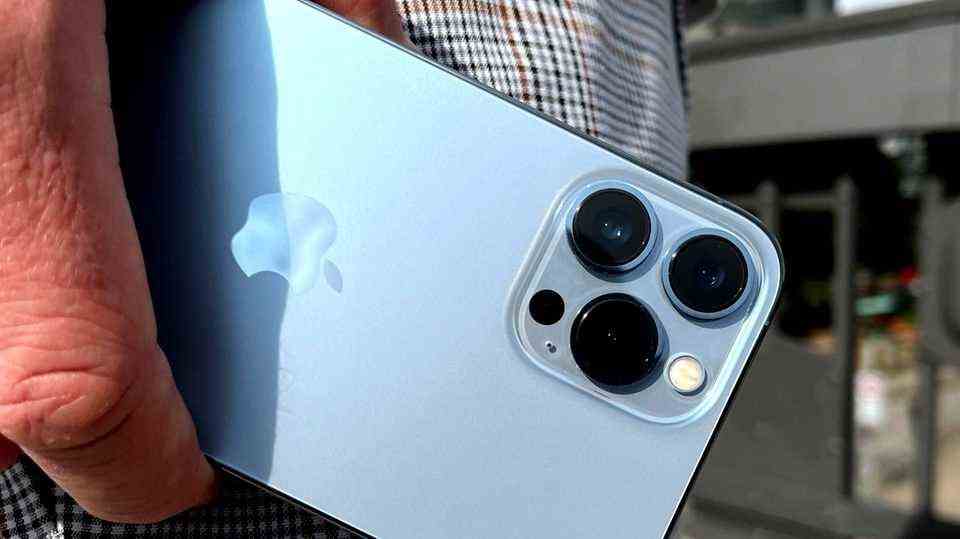With the iPad Mini, Apple surprisingly relaunched its smallest tablet two years ago. With the new iPad Mini 6, it will be upgraded again significantly. And thereby gets a completely new role.
Who needs a mini tablet these days? That was the first question that popped into my head when the iPad Mini was re-launched two years ago. Smartphones are now almost as big, tablets are available with screens that are almost four times the size. And I was spoiled for a long time with my 12.9 inch iPad Pro with a lot of space. When Apple presented the new, greatly improved iPad Mini 6, I was accordingly skeptical. And was quickly proven wrong in the test.
Because with the redesign, Apple has actually rethought its smallest tablet from the ground up. There is the new design, the better technical equipment – and also the now noticeably higher price. The only thing that the device has in common with the old iPad Mini is ultimately the name. And the small housing dimensions.

Thanks to the narrower display edge, Apple can accommodate more display in the case of the iPad Mini with almost the same dimensions
© Malte Mansholt / stern
Constant companion
And that’s exactly what makes it astonishingly suitable for everyday use. Because: unlike my large Pro model or the iPad Air, the iPad Mini can also be placed in a breast pocket or coat pocket – and suddenly accompanies me much more often than was the case with the other tablets. Whether while waiting for the hairdresser appointment, the bus ride or in the mobile phone holder of the car as a large navigation system: the iPad Mini is always at hand. Thanks to the new 5G support, you can even have your own internet connection. If it also had a phone app, I would probably even leave my iPhone at home occasionally.
The fact that the added value compared to the iPhone is so great, however, is due to the major revisions that Apple has granted its smallest tablet. On the one hand, there is the new design: While the predecessor came up with a 7.8-inch screen diagonal and a still considerable border including a home button, the new model is clearly based on the chic new look of the iPad Air or iPad Pro. In plain language this means: the edges are narrower, the sides more angular and the home button has been deleted. The big advantage: Although the housing dimensions have remained almost the same, the 8.3-inch display has become noticeably larger – and is therefore sufficiently different from large smartphone screens.
Whenever I need a little more space, for example when surfing, for a quick Netflix episode or a short note in between with the Apple Pencil, the tablet is used instead of the iPhone. Wait, some will say, other manufacturers have long since offered this in the form of foldables in a single device. That’s correct. But it doesn’t feel as round on any of these devices as it does on the iPad Mini. At least so far. Apple does not yet offer such a folding model. The fact that the iPad Mini is only slightly wider than two iPhones lying next to each other can now be interpreted by everyone as they wish.
Small power pin
An important factor for the good feeling of use is that the iPad Mini – apart from the display size – does not feel like a compromise. This is due to the fact that Apple technically did not mess up, but plopped up. The Mini is the first iPad to support Apple’s new A15 chip and, thanks to an additional graphics core, offers even more computing power than the basic models of the iPhone 13. Only the iPhone 13 Pro and the iPad Pro equipped with the M1 chip currently offer more power. And that although the iPad Mini costs significantly less.
This performance is definitely noticeable in everyday life. No matter whether it’s fast games, live calculation of video content or graphics programs: Everything I do with the iPad slips across the screen.
Even with video telephony, the little one is now catching up with the Pro models: It now supports the so-called follow-up mode in Facetime. If you move through the room, this is recognized by the 12 MP front camera and it realigns the image. So you don’t always have to move the iPad back and forth when making a video call while cooking, for example. If another person comes into the picture, this is also recognized and the iPad zooms out independently so that it can also be integrated into the picture. That worked great in everyday life. Apple’s already great video telephony looks even more sophisticated.

Compared to the 11-inch iPad Air, the iPad Mini looks tiny
© Malte Mansholt / stern
Small but mighty
The redesigned display itself is also a lot of fun. Apple continues to rely on LCD instead of OLED as with the iPhone or the Pro models. Because of the high resolution of 2266 x 1488 pixels, the strong color representation and the usually sufficiently high brightness even outside, it is still one of the best tablet displays. It is a shame that, unlike the Pro models of the iPad and the iPhone 13, the high frame rate of 120 Hertz and “only” 60 Hertz is supported, but it is manageable. A small drawback: If you scroll over longer texts, the left side of the screen in portrait mode slightly follows, which creates a somewhat strange effect. But that’s not really annoying.
The aspect ratio has also changed due to the narrower border. Instead of 4: 3 as before, Apple now almost uses the more modern 3: 2 ratio and thus finds a good compromise between the very wide 16: 9 format that is common on many Android tablets and the somewhat outdated ratio of the predecessors. The bars in videos become narrower, but there is still more space for other content! Which, above all, makes upright use more pleasant.

Apple is based on the new design line with clear edges for the iPad Mini 6
© Malte Mansholt / stern
Speaking of portrait: the iPad Mini is unusually flexible when changing the side you are using. It has to do with a design decision. The volume buttons have changed from the long to the short side, they are now at the “upper” end, next to the power button, which also contains the well-functioning fingerprint scanner. Because of the camera located there, it makes sense to leave this side up. But it is not a must. This is ensured by a trick on the volume buttons: They change roles depending on the position of the device. It always gets louder with the button that is higher up or further to the right in portrait mode. After a short period of getting used to it, I never have to think about which key to press.
Connoisseur-friendly
The use of the Apple Pencil is not quite as flexible. With the redesign, the iPad Mini now supports the second generation of the smart pen. As with the iPad Pro or the iPad Air, it can be clipped onto the side, transported and charged. This is only possible on the right side of the device from the power button, so there is basically a clearly defined “top” when you attach the pen. By the way, the pen stays in place there as usual. It’s a shame: Apple doesn’t offer a keyboard case like the one for the larger iPads.

The fact that the second generation of the pen is supported also enables another innovation: With the switch to the second Apple Pencil, there is no longer any need to use Apple’s Lightning connector, which was used to connect the first generation of the pen. Like the more expensive iPads, the iPad Mini now also uses the modern USB-C connection. This enables faster data rates for transmission via the cable, but also enables peripheral devices such as external hard drives to be connected. In the test, I was even able to use a docking station to operate the mouse, keyboard and monitor at the same time on the small tablet and write part of this text over it. If you want, you can even use it as a desktop replacement if the minor restrictions of the iPadOS, which is actually intended for tablets, do not interfere.
But then it should also be regularly plugged in. The iPad Mini charges a little faster than its predecessor with the supplied 20 watt power supply, but it doesn’t last much longer. After a few hours of use it is over, for heavy users it will rarely last more than a day. More often, the juice will run out even before evening. But because most people use their tablet less often than their smartphone, it should still usually last several days in everyday practice. This is also perfectly fine for the small case.
Conclusion: no compromises
With the sixth generation of the iPad Mini, Apple has made a great everyday companion in a small format. With a lot of power, lots of convenience functions and a great new design, the iPad Mini has been significantly upgraded and now offers almost the full iPad experience without feeling like a compromise. Smaller flaws like the scroll effect and the missing keyboard cover only marginally spoil the fun.
Anyone looking for a small tablet will get their money’s worth here. However, this has its price: The new iPad Mini costs at least 550 euros online, and the version with 5G support costs as much as 700 euros. That’s a lot of money when you consider that you can get an iPad Pro for just under 100 euros more. But that’s also bigger.
In terms of its combination of performance and size, the iPad Mini is currently unrivaled. An alternative in terms of size is Samsung’s Galaxy Tab Active 3 outdoor tablet. Despite the smaller screen, it is not quite as compact and also offers less performance, but is significantly cheaper with a price starting at 370 euros. If you want an iPad, you can look at the revised entry-level iPad or the fourth generation iPad Air as an alternative. Both are significantly larger with 10.2 or 11 inch display diagonals.

